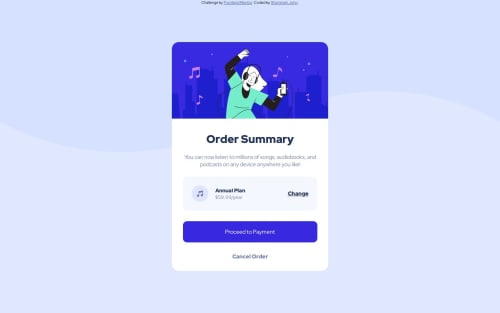Order Summary Project

Solution retrospective
I’m most proud of the responsiveness and clean design I achieved. I focused a lot on ensuring that the layout looked great on both desktop and mobile devices, which involved a lot of media queries and flexible units. Also, I’m really happy with the smooth animations and transitions that add a touch of interactivity without being overwhelming. Seeing everything come together as a polished, user-friendly interface was incredibly satisfying. Next time, I’d plan the project structure more thoroughly before jumping into coding. I realized halfway through that some of my initial decisions on file organization and component structure weren’t the most efficient, which made things a bit messy to manage. I’d also like to spend more time on accessibility features, ensuring the site is usable for people with various disabilities. Lastly, I’d like to experiment more with modern CSS features like Grid and Flexbox to improve the layout even further.
What challenges did you encounter, and how did you overcome them?One of the biggest challenges I encountered was making sure the layout was perfectly responsive across different devices. Initially, some elements didn’t scale as expected, causing a few headaches with alignment and spacing. I overcame this by diving deeper into CSS Grid and Flexbox, which provided a more robust solution for creating flexible layouts.
Another challenge was optimizing the images for different screen sizes to maintain a balance between visual quality and loading speed. I tackled this by using the srcset attribute and different image formats, ensuring that the appropriate image was loaded for each device.
What specific areas of your project would you like help with?I’d love some help with the following areas of my project:
Accessibility: While I tried to follow best practices, I’m not entirely confident that the site is fully accessible. Guidance on improving keyboard navigation, ARIA roles, and ensuring compatibility with screen readers would be invaluable.
Performance Optimization: I want to ensure that the site loads quickly and performs smoothly, especially on mobile devices with slower connections. Any tips on further optimizing images, reducing render-blocking resources, and improving overall load times would be greatly appreciated.
Advanced CSS Techniques: I’m keen to learn more about advanced CSS, particularly Grid and Flexbox layouts. While I used these tools, I feel there’s a lot more I could do to refine my layouts and make them even more responsive and elegant.
Please log in to post a comment
Log in with GitHubCommunity feedback
No feedback yet. Be the first to give feedback on shammah john's solution.
Join our Discord community
Join thousands of Frontend Mentor community members taking the challenges, sharing resources, helping each other, and chatting about all things front-end!
Join our Discord